Air Test (Bench Test), page 2
How To Set Up and Conduct Air Test To Determine Your Metal Detector's Depth Potential and Learn Audio and Visual Responses to Targets
If you do not have a "Coins" search program customized for specific metal detecting conditions in your area, it is best to use a factory preset program "Coins" (or "Coins and Jewelry") as a basic program to be modified during the air test.
And, of course, you need coins, including silver ones, of different denominations and a variety of other items consisting of both the valuable targets (gold and silver rings, earrings, metal buttons, etc.) and junk targets (foil, screw caps, beer bottle caps, pull tabs, brass casings, nails, etc.). The more, the better! Just make sure you know the metal composition of each item.
To conduct Air Test, you should follow these steps:
1. Place your metal detector horizontally on a non-metallic surface. If it is a table or bench, make sure a search coil is not near any screws, nails, or bolts. I suggest to conduct air testing outdoors - away from any house wiring, electric devices or sources of electromagnetic interference (EMI), like in the field. But first locate a spot on the ground free of metal and highly non-conductive objects such as hot rocks and black sand deposits as well as "hot mineral pockets" of high intensity.
2. Set a search coil perpendicular to the ground surface, and onto a 16-inch (40cm) long plastic or wooden ruler in the way that the search coil's edge would rest at a "0" mark (this is a set up for steps ).
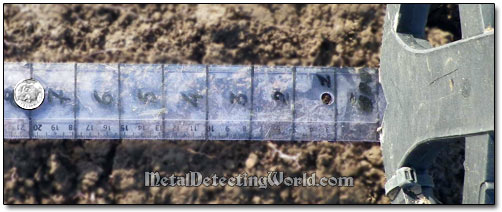
NOTE: Do not place your detector's control box too close to the search coil or the control housing may disrupt your air testing.
3. Remove your wrist watch and all jewelry from your hands. Also take off your jacket or windbreaker if it has metal buttons on sleeves.
4. Turn the Sensitivity control to maximum.
5. Set Discrimination at zero (All Metal mode).
6. Set the Ground Rejection Level at 75%-85% by adjusting the Manual Ground Balance control (if it is available).
7. Set your metal detector's Audio in MULTI TONES (if this feature is available and not to be confused with just a 3-tone (low, medium and high) audio mode). In the Multi Tones (usually around 250 tones) audio mode, for example, audio responses to silver and copper coins will be of a high-pitched tone while responses to gold items and foil will sound in lower tones, and iron targets will produce the lowest buzz.
It is important to memorize tonal IDs of certain targets and train your ears to discern sound characteristics of various types of targets, for instance, classified by shape, such as coins and tokens (disc shaped targets), brass casings (targets of complex but regular shape), foil and can slaw (targets of irregular, sometimes complex shape), etc.
8. Prepare a few wooden or plastic slats with coins attached to them. It is much easier to observe an accurate distance reading on the ruler when using a coin slat than when just holding a coin in your hand. I use the slats made of transparent Plexiglas, and scotch the coins to them to be able to see without confusion what coin I am actually testing. Initially I made these sharp-pointed slats for the "Depth Penetration Test" (a link will be posted soon) to determine effects of current mineralization on the detector's Depth Penetration ability, which would require insertion of the slats into a side wall of a test hole.
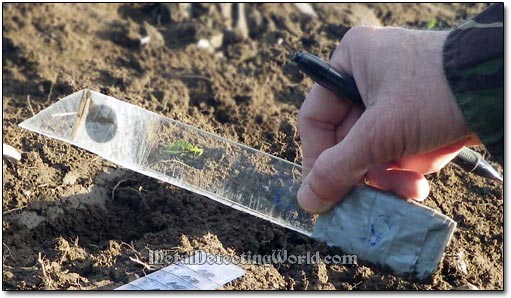
Get Familiar with Targets' VDI Values and Record Them into a Target VDI Chart
9. Pass the coin slat in front of the search coil and observe which coin's position in relation to the coil makes the detector respond with the strongest and clearest signal. Obviously, when the coin is parallel to the search coil's plane and positioned on a height level of the coil's center, the audio response sounds the best, and the coin's VDI readout is not changing with every sweep of the slat.
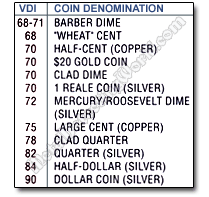
This is when you should record the coin's VDI value into your Target VDI Chart (a portion of a VDI chart is shown to the right, and a better example would be My 100-Target VDI Chart for an XP Deus metal detector) before you proceed further with steps described below.
After you complete your chart, your goal will be to memorize which conductivity zones are occupied by which metals or metal alloys, and at which points of the Conductivity scale VDI readings (conductivity values) of certain targets in focus (specific coins or jewelry) "landed".
Of course, you will not be able to memorize all numbers right away, that is why, later, in the beginning of your metal detecting activity at a real hunt site, you should carry your VDI chart with you so that it would help you navigate among various VDI readouts of real targets. The VDIs of some real targets may be slightly different but you should not worry about it at that point.
Learn Your Detector's Audio Responses to Various Targets
You will soon learn that superficial coins emit "clean", "solid" and "unmistakable" signals because most metal detectors are calibrated on coins (targets of a perfect disc shape). Audio responses to the rest of the non-ferrous targets will vary in their sound characters according to the targets' types categorized by shapes, metal compositions and other properties.
If your hearing capacity is average or better, you, for instance, will be able to hear difference between sound characters of a .75 cal musket ball and a 1982 Memorial cent, even though both targets have the same VDI values and, therefore, audio responses to them would have the same high-pitched tones. The more you practice, the more sensitive to slight changes in sound character your ears become, provided your metal detector is designed to give you such information.
Obtain Depth Potential for Assorted Targets
10. Gradually move the coin slat outward until you can just barely hear the response. The "stop point" should be determined based on your judgment: whether you would dig up a target emitting this signal or not in real detecting situation. Then the test results would be fair. I suggest to designate stop points at the spots where the responses to targets become faint but still sound "two-way".
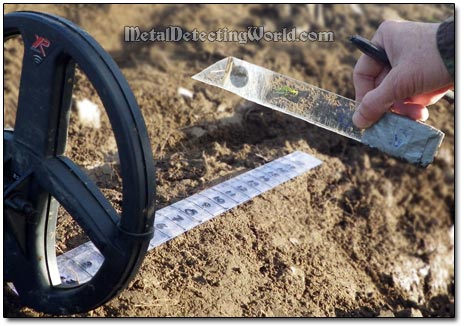
11. Record the obtained distance ("depth") for the coin in a "Target VDI Log" (if you are testing just this particular coin with different settings of Sensitivity, Ground Balance, Discrimination, etc.), or in a "Target VDI Chart" if you are air testing various targets, both desirable and undesirable.
12. If you have a search program that you will be using for your upcoming metal detecting project, adjust the Sensitivity, Ground Balance, Discrimination, and other key-settings according to this program, and repeat the test with targets in focus. Record all test data and compare with previous results. This info will be essential for your understanding how different program settings interact with each other and affect the detector's responses to desirable targets. You may want to air test targets in focus with a larger search coil to see how different the detector's Depth Potential for these targets can be with a different coil. But this will be just "half job" done...
Optimize Your Search Program Through "Mineralization/Depth Penetration Test" or at Test Garden
Once again, under real conditions, there are many variables that present obstacles to the detector's transmit power and, therefore, to its Depth Penetration. The actual VDI readouts and operational depth ranges for the same targets may greatly deviate downward from both the Air Test and Mineralization/Depth Penetration Test (a link will be placed here soon) results.
If you construct an outdoor Test Garden, you will have almost real metal detecting conditions for testing various targets and optimizing your search program settings. You will certainly be able to factor the combined effects of local mineralization ( if it is high, the High Mineralization Effect will take place) and surrounding iron content (Mixed VDI Value Effect) in test conditions. (both effects are described in my article Factors That Affect VDI Readings of Non-Ferrous Targets) The "job" will be done after you complete your search program optimization. And then you will be ready for real action!
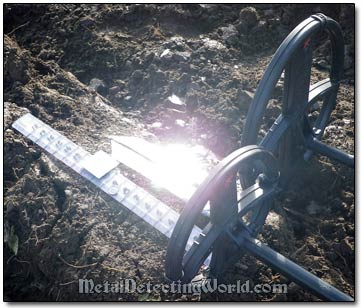
Happy Hunting!
If you would like to point out any errors or express your opinion, please do not hesitate to send me a message!
If you would like to point out any errors or typos or express your opinion, please do not hesitate to send me a message via e-mail.
Make a Donation
Please help me stay afloat, afford more metal detecting trips with field-tests and experiments to create more informative articles, useful tutorials and helpful guides for detectorists, and maintain this website - the most informative hobby resource on the web! Since I do not have any steady income, any donation matters to me a lot! Thank you kindly!
Clicking on the donate button will take you to a donation page powered by Donorbox and dedicated to my website (MetalDetectingWorld.com). The donation page is PCI-compliant, secured by SSL/TLS, and has a simple form to fill out. Donorbox does not store any card or bank data. Credit card information is encrypted and tokenized by the Stripe payment processor.
This website would not exist without the advertisements we display and your kind donations. If you are unable to support us by viewing our advertisements, please consider making a Donation to ensure the future of this website. By helping me keep this website alive and growing, you will sure help many detectorists around the world as well!
ANNOUNCEMENT:
In January of 2020, I started a one-time fund-raising campaign in attempt to accumulate enough money to buy a simple but reliable 4x4 vehicle. My old 4x4 car (made in 1995) had faithfully served me for 10 years before it eventually went beyond repair last October. Without a 4WD, I will not be able to get to my hunt sites and test-plots hidden in the remote wooded areas inaccessible by a regular car.
Unlucky for me, those sites are the only locations available and suitable for my field-work which results in informative articles you can find on this website. For the past 10 years, my usual field-work has consisted of field-testing the latest metal detectors and accessories, experimenting with some of them, and devising new effective search methods that meet the requirements of the new metal detecting reality.
Before my car died, I managed to finish a couple of interesting detector-testing projects which will be covered in my upcoming articles. But other equally important projects that I was working on were not completed and had to be postponed until the Spring 2020. I hope that this fund-raising campaign will help me get a decent 4x4 by then so that I will be able to resume my work and to write more new articles, tutorials and guides based on data gathered through testing and experimentation.
If you find my website useful and would like it to provide more essential info for you and other detectorists worldwide, please consider chipping in $5, $20, $50 or whatever you can afford to keep MetalDetectingWorld.com growing in 2020. I promise you, it will be money well spent. Thank you.
Donate- Please help me promote this article:
If you would like to follow me on Twitter, please press a button:
I have my profile page on
where you can share your thoughts on this article, ask me a question, or place a friend request.I also have my profile pages on Pinterest, LinkedIn, Tumblr, Reddit and Delicious
and my "Metal Detecting World" page on Twitter, Pinterest and Tumblr
I no longer maintain my old Facebook page